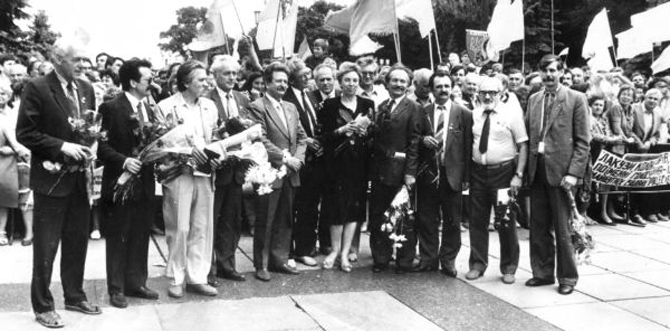Declaration on the State Sovereignty of Ukraine
Declaration on the State Sovereignty of Ukraine (Декларація про державний суверенітет України; Deklaratsiia pro derzhavnyi suverenitet Ukrainy). An act of the Supreme Soviet of the Ukrainian SSR adopted on 16 July 1990 by a vote of 355 to 4. The declaration asserted the right of the Ukrainian SSR to self-determination, defined the Ukrainian people on a non-ethnic basis as being all its citizens, guaranteed every citizen equality before the law, and declared the republic’s supreme authority over its own territory. It decreed that Ukrainian SSR laws took precedence over the laws of the USSR on the Ukrainian territory, and declared that the Ukrainian SSR would maintain its own army and its own national bank with the power to introduce its own currency. It also made clear Ukraine’s determination to be independent insofar as economic, ecological, and cultural policies were concerned. The new republic would protect all forms of property and would institute a cultural revival. In foreign affairs the declaration proclaimed the Ukrainian SSR as having the right to maintain direct relations with other states, to observe the norms of international law, and to conclude international agreements. Relations with other republics of the USSR would be conducted on the basis of equality, mutual respect, and non-interference in each other’s internal affairs.
The declaration was an important stage on Ukraine’s road to independence. In the tumultuous political processes within the USSR stimulated by Gorbachev’s policy of perestroika, his calls for democratization were taken in directions not foreseen by their author. The loosening of ties between Moscow and union republics began with semi-competitive elections to republic supreme soviets which challenged the Communist Party’s monopoly and eventually led to a ‘parade of sovereignties.’ In adopting the Declaration of Sovereignty, Ukraine’s Supreme Soviet was following the example of its counterpart in the RSFSR. However, the Ukrainian declaration was more radical than had been expected due to the efforts of a nationally-conscious opposition caucus in the Supreme Soviet of the Ukrainian SSR. One year later, the declaration was succeeded by the 1991 Ukraine’s Declaration of Independence that ushered in the new era of an independent, post-Soviet Ukrainian state.
BIBLIOGRAPHY
Solchanyk, R. ‘Ukraine: From Sovereignty to Independence,’ RFE/RL Research Report 1, no. 1 (3 January 1992)
Solchanyk, R. (ed) Ukraine: From Chernobyl' to Sovereignty (Edmonton 1992)
Kuzio, T.; Wilson, A. (eds) Ukraine: Perestroika to Independence (Edmonton and Toronto 1994)
‘Declarations of the State Sovereignty of the Russian and Ukrainian Republics,’ in The Soviet System: From Crisis to Collapse, ed A. Dallin and G. W. Lapidus, rev edn (Boulder 1995)
Bohdan Harasymiw
[This article was written in 2023.]

.jpg)